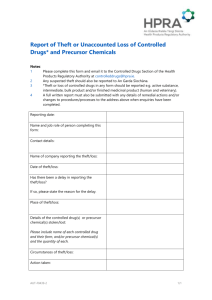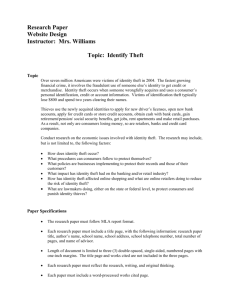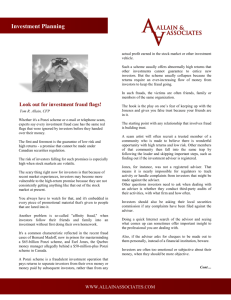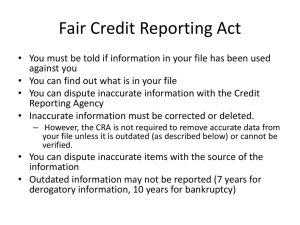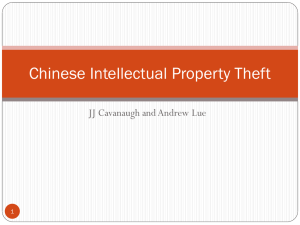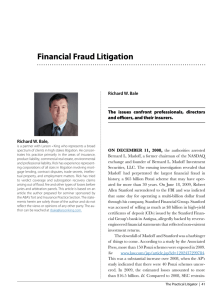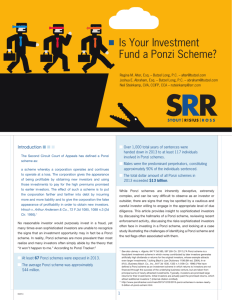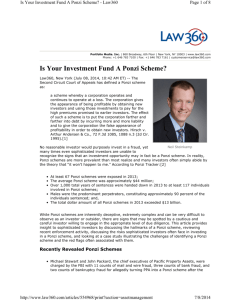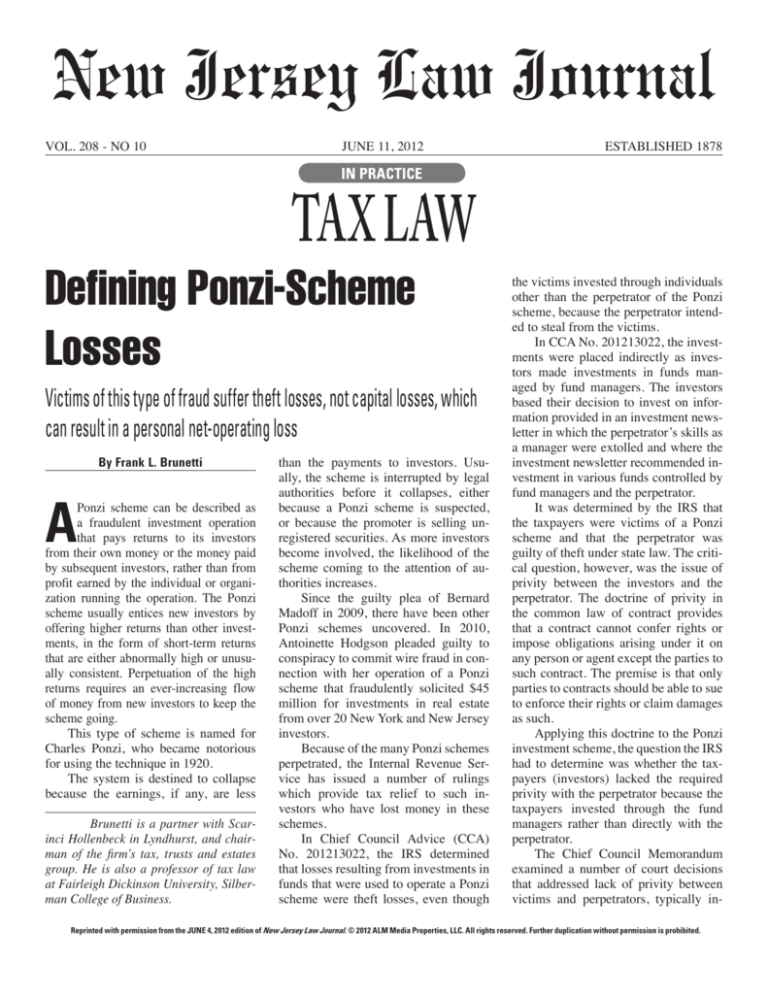
New Jersey Law Journal
VOL. 208 - NO 10
JUNE 11, 2012
TAX LAW
Defining Ponzi-Scheme
Losses
Victims of this type of fraud suffer theft losses, not capital losses, which
can result in a personal net-operating loss
By Frank L. Brunetti
A
Ponzi scheme can be described as
a fraudulent investment operation
that pays returns to its investors
from their own money or the money paid
by subsequent investors, rather than from
profit earned by the individual or organization running the operation. The Ponzi
scheme usually entices new investors by
offering higher returns than other investments, in the form of short-term returns
that are either abnormally high or unusually consistent. Perpetuation of the high
returns requires an ever-increasing flow
of money from new investors to keep the
scheme going.
This type of scheme is named for
Charles Ponzi, who became notorious
for using the technique in 1920.
The system is destined to collapse
because the earnings, if any, are less
Brunetti is a partner with Scarinci Hollenbeck in Lyndhurst, and chairman of the firm’s tax, trusts and estates
group. He is also a professor of tax law
at Fairleigh Dickinson University, Silberman College of Business.
than the payments to investors. Usually, the scheme is interrupted by legal
authorities before it collapses, either
because a Ponzi scheme is suspected,
or because the promoter is selling unregistered securities. As more investors
become involved, the likelihood of the
scheme coming to the attention of authorities increases.
Since the guilty plea of Bernard
Madoff in 2009, there have been other
Ponzi schemes uncovered. In 2010,
Antoinette Hodgson pleaded guilty to
conspiracy to commit wire fraud in connection with her operation of a Ponzi
scheme that fraudulently solicited $45
million for investments in real estate
from over 20 New York and New Jersey
investors.
Because of the many Ponzi schemes
perpetrated, the Internal Revenue Service has issued a number of rulings
which provide tax relief to such investors who have lost money in these
schemes.
In Chief Council Advice (CCA)
No. 201213022, the IRS determined
that losses resulting from investments in
funds that were used to operate a Ponzi
scheme were theft losses, even though
ESTABLISHED 1878
the victims invested through individuals
other than the perpetrator of the Ponzi
scheme, because the perpetrator intended to steal from the victims.
In CCA No. 201213022, the investments were placed indirectly as investors made investments in funds managed by fund managers. The investors
based their decision to invest on information provided in an investment newsletter in which the perpetrator’s skills as
a manager were extolled and where the
investment newsletter recommended investment in various funds controlled by
fund managers and the perpetrator.
It was determined by the IRS that
the taxpayers were victims of a Ponzi
scheme and that the perpetrator was
guilty of theft under state law. The critical question, however, was the issue of
privity between the investors and the
perpetrator. The doctrine of privity in
the common law of contract provides
that a contract cannot confer rights or
impose obligations arising under it on
any person or agent except the parties to
such contract. The premise is that only
parties to contracts should be able to sue
to enforce their rights or claim damages
as such.
Applying this doctrine to the Ponzi
investment scheme, the question the IRS
had to determine was whether the taxpayers (investors) lacked the required
privity with the perpetrator because the
taxpayers invested through the fund
managers rather than directly with the
perpetrator.
The Chief Council Memorandum
examined a number of court decisions
that addressed lack of privity between
victims and perpetrators, typically in-
Reprinted with permission from the JUNE 4, 2012 edition of New Jersey Law Journal. © 2012 ALM Media Properties, LLC. All rights reserved. Further duplication without permission is prohibited.
2
NEW JERSEY LAW JOURNAL, JUNE 11, 2012
volving taxpayers who purchased shares
of stock on the open market and who
later lost their investment because the officers or directors stole money from their
corporation. In those cases, the court held
that there was no criminal intent on the
part of the perpetrators to deprive the taxpayers of their property, and therefore the
losses were capital losses, not theft losses. Moreover, the courts in these cases
held that theft losses were not available
because of lack of privity. In the open
market cases, the taxpayers’ property
ended up in the hands of the parties on
the other side of the market transaction
and not within the theft scheme itself.
In CCA No. 201213022, the IRS
rejected the application of the open market cases and instead determined that
the Ponzi scheme in question was more
similar to that examined by the Tax Court
in Jensen v. Commissioner, T.C. Memo.
1993-393, where the Tax Court found
that the taxpayers were in privity with the
perpetrators of a Ponzi scheme, because
the individual through whom they invested was merely a broker or conduit to
the scheme. In Jensen, the perpetrators of
the scheme referred potential investors to
business associates so that they could invest in the scheme. The Tax Court in Jensen held that there was no requirement
that the investor have direct contact with
the entity in which he invested and that
the business associate acted as a conduit
for the taxpayer’s funds because the taxpayer gave the business associate those
funds for the sole purpose of investing in
the scheme.
The Chief Council Memorandum
concluded that the facts were analogous
to Jensen and, unlike the frauds alleged
in the open market cases, the funds ended
up in the scheme at the disposal of the
perpetrator. The fund managers’ role
in soliciting funds that were paid into
the scheme did not deprive the taxpayers of privity with the perpetrator. Thus,
the IRS ruled that the taxpayers’ losses
were theft losses for purposes of Section
165, even though the taxpayers invested
through individuals other than the primary perpetrator of the scheme.
Investors who are victimized by
Ponzi schemes have to hurdle many obstacles in order to obtain a theft loss.
The principal basis for taking the
loss is set forth in Revenue Ruling 20099. The Ruling provides that a cash method taxpayer who invested sums of money
with another individual who held himself
out as an investment advisor but was later shown to have used funds in a Ponzitype scheme was entitled to a theft loss.
A theft loss is not capital loss because
it arises from a transaction entered into
for profit and is an ordinary loss deductible against ordinary income. The Ponzi
victim can use the loss against ordinary
income, or carry the loss back or forward
under the net operating loss (NOL) rules.
A theft loss in a transaction entered
into for profit is deductible under Section
165(c)(2), not Section 165(c)(3), as an
itemized deduction that is not subject to
the personal loss limits in Section 165(h),
or the limits on itemized deductions in
Sections 67 and 68.
A theft loss in a transaction entered
into for profit is deductible in the year the
loss is discovered, provided that the loss
is not covered by a claim for reimbursement or recovery with respect to which
there is a reasonable prospect of recovery.
The amount of a theft loss in a trans-
208 N.J.L.J. 791
action entered into for profit is generally
the amount invested in the arrangement,
less amounts withdrawn, if any, reduced
by reimbursements or recoveries, and
reduced by claims as to which there is a
reasonable prospect of recovery. Where
an amount is reported to the investor
as income prior to discovery of the arrangement, and the investor includes
that amount in gross income and reinvests this amount in the arrangement, the
amount of the theft loss is increased by
the purportedly reinvested amount.
A theft loss in a transaction entered
into for profit may create or increase a
net operating loss under Section 172,
which can be carried back up to three
years and forward up to 20 years. An
eligible small business may elect either
a three-, four- or five-year net operating
loss carry-back for an applicable 2008
net operating loss.
A theft loss in a transaction entered
into for profit, however, does not qualify
for the special computation of tax provided by Section 1341, nor does it qualify
for the application of Sections 1311-1314
to adjust tax liability in years that are otherwise barred by the period of limitations
on filing a claim for refund under Section
6511.
Following the guilty plea of Bernard
Madoff in his notorious Ponzi-style investment fraud case, the IRS has issues
several pronouncements providing taxpayer relief. In 2009, the IRS also issued
Rev. Proc. 2009-20. This Revenue Procedure provides an optional safe harbor under which qualified investors (as defined
in the procedure) may treat a loss from a
criminal fraudulent investment arrangement as a theft loss deduction when certain conditions are met.


